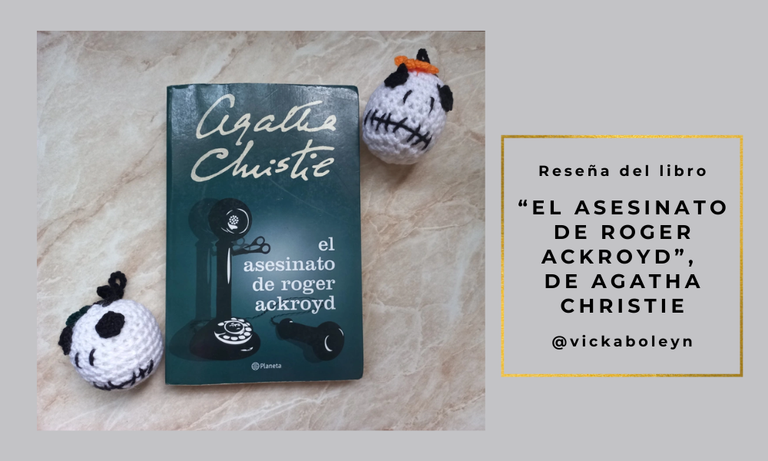Advertencia: Esta reseña puede contener spoilers; si quieres leer la reseña sin spoilers, haz click aquí. La traducción al inglés fue elaborada con ayuda de Deepl Translator.
Warning: The following review may contain spoilers; if you want to read the review without spoilers, please click here.

Fotografía de autoría propia. Banner elaborado con Canva / Picture by me. Banner made with Canva
Español
Una noche, Roger Ackroyd está en su oficina en compañía del doctor James Sheppard, amigo suyo desde hace años. Los dos discutían la lamentable muerte de la señora Ferrars, con quien Ackroyd pretendía casarse; la mujer, quien por un cargo de conciencia decidió suicidarse, le dejó una última carta a Ackroyd, la cual revelaba un secreto mortal.
¿Qué era ese secreto? La identidad de un chantajista que conocía muy bien un oscuro secreto de la señora Ferrars relacionado con la muerte de su primer marido. ¿Quién era ese chantajista? Nadie sabe, nadie supo. Ackroyd fue apuñalado esa misma noche, y el doctor Sheppard, junto con Parker, el mayordomo, descubren la horrorosa escena luego de una llamada telefónica que el médico recibió en su casa.
Así comienza lo que considero una de las novelas más trepidantes de Agatha Christie, la gran Reina del Crimen, protagonizada por su icónico personaje, el detective belga Hercule Poirot. Un libro que te deja pensando en la importancia de los detalles en apariencia insignificantes, en los dos lados de la naturaleza humana, en cómo la información y el conocimiento son sinónimo de poder, de dominio implacable.
Un aspecto interesante de este libro es la forma en que la autora narra la historia, pues el estilo es parecido al de un diario escrito por una persona que ha participado en la investigación. En este caso, es el doctor Sheppard, el co-protagonista de la historia, quien nos va guiando a través de lo que parece ser un caso en apariencia sencillo pero a su vez enredado. Un caso en el cual los sospechosos, a quienes el médico conoce bastante bien, parecen sentirse amenazados por la revelación de sus propios secretos.
Algunos ocultamientos suelen ser inofensivos, producto de la desesperación, como es el caso del robo de los 40 libras por parte de Flora Ackroyd, la sobrina del occiso; otros suelen ser un tanto más complicados, como es el caso de la relación de la señora Russell, la ama de llaves, con su hijo, un criminal de poca monta adicto a las drogas.
Sin embargo, es el propio Poirot quien, con la ayuda de sus famosas células grises, devela el secreto más mortal de todos: la identidad del chantajista. ¿Quién era esa persona que llevó al suicidio a la señora Ferrars con su chantaje y asesinó a Ackroyd?
Habría que leer el libro para averiguarlo.

English
One night, Roger Ackroyd was in his office accompanied by Dr. James Sheppard, his friend for years. Both of them were discussing the unfortunate death of Mrs. Ferrars, whom Ackroyd intended to marry; the woman, who out of a guilty conscience decided to commit suicide, left Ackroyd a last letter, which revealed a deadly secret.
What was that secret? The identity of a blackmailer who knew very well Mrs. Ferrars' dark secret related to the death of her first husband. Who was this blackmailer? No one knows, no one knew. Ackroyd was stabbed that same night, and Dr. Sheppard, along with Parker, the butler, discover the horrific scene after a phone call the doctor received at his home.
This is how begins what I consider one of the most thrilling novels of Agatha Christie, the great Queen of Crime, starring her iconic character, the Belgian detective Hercule Poirot. A book that leaves you thinking about the importance of seemingly insignificant details, about the two sides of human nature, about how information and knowledge are synonymous with power, of relentless domination.
An interesting aspect from this book is the way the author narrates the story, as the style is similar to that of a diary written by a person who has participated in the investigation. In this case, it's Dr. Sheppard, the co-protagonist of the story, who guides us through what appears to be a seemingly simple but tangled case. A case in which the suspects, whom the doctor knows quite well, seem to feel threatened by the revelation of their own secrets.
Some concealments tend to be harmless, product of desperation, like the the case of the theft of the 40 pounds by Flora Ackroyd, the niece of the deceased; others tend to be somewhat more complicated, as in the case of the relationship of Mrs. Russell, the housekeeper, with her son, a petty criminal addicted to drugs.
However, is Poirot himself who, with the help of his famous grey cells, reveals the most lethal secret of all them: the identity of the blackmailer. Who was this person who drove Mrs. Ferrars to suicide with its blackmail and murdered Ackroyd?
You would've read the book to find out.
Sin duda, me dejaste con ganas de leer el libro y descubrir quién es el chantajista. ¡Gracias por compartir tu análisis!
¡Hola, @jessuses1381 ! Te aseguro que este libro te va a dejar con la boca abierta. Si en algo es experta la gran Reina del Crimen es no dejarte pistas (y si las deja, pues será de forma muy, pero muy sutil) hasta el final, cuando el protagonista revela ante todo el mundo quién lo hizo. ¡Saludos y que tengas un bonito día!
Agatha's books are part of my childhood. I have fond memories with those books. Thanks for sharing your review 😊
Hi, @kathajimenezr ! Thank you so much for your kind words. My first contact with Agatha's books, ironically, was through the 1989 series Agatha Christie's Poirot; in fact, one of my first books I read from her was Cat among the pigeons, which was very wonderful and I was looking for reading more of Poirot's and Miss Marple's series. Hugs and have a great day!